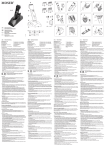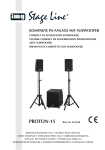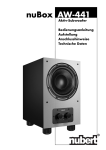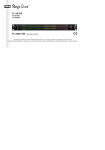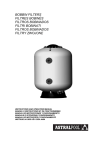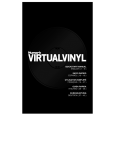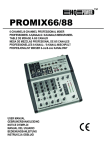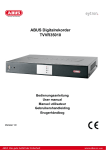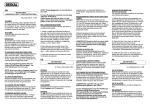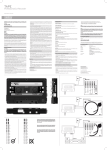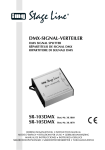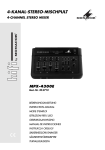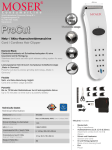Download USB-AUDIO-INTERFACE
Transcript
USB-AUDIO-INTERFACE USB AUDIO INTERFACE INTERFACE AUDIO USB INTERFACCIA AUDIO USB USB-SOUNDBOX Best.-Nr. 21.2200 BEDIENUNGSANLEITUNG • INSTRUCTION MANUAL MODE D’EMPLOI • ISTRUZIONI PER L’USO MANUAL DE INSTRUCCIONES • INSTRUKCJA OBSŁUGI D A CH Bevor Sie einschalten ... F Avant toute mise en service ... B Lisez ce mode d’emploi entièrement avant toute utilisation. Uniquement ainsi, vous pourrez apprendre l’ensemble des possibilités de fonctionnement de l’appareil, éviter toute manipulation erronée et vous protéger, ainsi que l’appareil, de dommages éventuels engendrés par une utilisation inadaptée. Conservez la notice pour pouvoir vous y reporter ultérieurement. La version française commence à la page 10. CH E GB Bitte lesen Sie diese Bedienungsanleitung vor dem Betrieb gründlich durch. Nur so lernen Sie alle Funktionsmöglichkeiten kennen, vermeiden Fehlbedienungen und schützen sich und Ihr Gerät vor eventuellen Schäden durch unsachgemäßen Gebrauch. Heben Sie die Anleitung für ein späteres Nachlesen auf. Der deutsche Text beginnt auf Seite 4. Antes de cualquier instalación ... Por favor, lea estas instrucciones de uso atentamente antes de hacer funcionar el aparato. De esta manera conocerá todas las funciones de la unidad, se prevendrán errores de operación, usted y el aparato estarán protegidos en contra de todo daño causado por un uso inadecuado. Por favor, guarde las instrucciones para una futura utilización. La versión española comienza en la página 16. Before you switch on ... Please read these operating instructions carefully prior to operating the unit. Thus, you will get to know all functions of the unit, operating errors will be prevented, and yourself and the unit will be protected against any damage caused by improper use. Please keep the operating instructions for later use. The English text starts on page 7. I Prima di accendere ... Leggete attentamente le istruzioni prima di mettere in funzione l’apparecchio. Solo così potete conoscere tutte le funzionalità, evitare comandi sbagliati e proteggere voi stessi e l’apparecchio da eventuali danni in seguito ad un uso improprio. Conservate le istruzioni per poterle consultare anche in futuro. Il testo italiano comincia a pagina 13. PL Przed Uruchomieniem ... Dzięki tej instrukcji obsługi będą państwo w stanie poznać wszystkie funkcje tego urządzenia. Stosując się do instrukcji unikną państwo błędów i ewentualnego uszkodzenia urządzenia na skutek nieprawidłowego użytkowania. Prosimy zachować instrukcję. Tekst polski znajduje się na stronie 19. ® w w w.imgstageline.com 2 USB-SOUNDBOX USB AUDIO INTERFACE INPUT FILTER GAIN TRIM SOURCE SIGNAL/ CLIP PHONO LINE LOW CUT FLAT 1 2 –10 MONITOR LEVEL 0 dB +10 3 S/PDIF IN 4 PC AUDIO OUT POWER PC PRE AMP MIX AUDIO 5 PREAMP OUT 6 ON OFF / USB 10 7 PHONO IN ➀ 8 LINE IN GND L R 9 V /~ 150 mA S/PDIF OUT 9 10 11 12 13 14 15 16 ➁ 17 Blockschaltbild • Block diagram PHONO IN L R PREAMP OUT L GND GAIN TRIM RIAA SIGNAL/ CLIP SOURCE PREAMP LINE IN L INPUT PHONO FILTER R S /PDIF IN PC AUDIO OUT D FLAT/ LOW CUT MONITOR MIX A LINE R LEVEL USB PC AUDIO OUT D A L R S/PDIF OUT ➂ 3 D A Bitte klappen Sie die Seite 3 heraus. Sie sehen dann immer die beschriebenen Bedienelemente und Anschlüsse. CH 1 Übersicht der Bedienelemente und Anschlüsse 1 Eingangswahlschalter PHONO/LINE 2 Schalter zum Aktivieren des Hochpassfilters; bei gedrückter Taste ist das Filter aktiv 3 Regler GAIN TRIM zum Anpassen der Eingangsverstärkung (±10 dB) 4 LED SIGNAL/CLIP: leuchtet grün, wenn ein analoges Eingangssignal vorhanden ist. Leuchtet sie rot, ist der Eingang übersteuert. In diesem Fall den Regler GAIN TRIM (3) zurückdrehen oder den Ausgangspegel der Signalquelle reduzieren. 5 Schalter SOURCE zur Wahl der Signalquelle für den Kopfhörerausgang (6): Position PREAMP: vorverstärktes Signal des Eingangs PHONO oder LINE Position PC AUDIO: über die USB-Verbindung kommendes Audiosignal vom PC Position MIX: beide Signalquellen (PREAMP und PC AUDIO) sind zu hören 6 3,5-mm-Klinkenbuchse MONITOR zum Anschluss eines Stereokopfhörers 7 Regler LEVEL zum Einstellen der Kopfhörerlautstärke 8 Schalter POWER zum Ein- und Ausschalten des Geräts; bei Verwendung des Steckernetztrafos zum Einschalten die Taste hineindrücken (die Taste leuchtet rot); bei Versorgung des Interfaces über die USB-Schnittstelle die Taste ausrasten (sie leuchtet blau) 9 Schraubklemme als Masseanschluss für einen Plattenspieler 10 USB-Buchse (Typ B) zum Anschluss eines Computers 11 Cinch-Buchse S/PDIF IN zum Anschluss einer Signalquelle mit Digitalausgang 12 Cinch-Buchse S/PDIF OUT; dieser Ausgang liefert ein vom angeschlossenen Computer kommendes digitales Audiosignal 13 Cinch-Buchsen PC AUDIO OUT; dieser Ausgang liefert ein vom angeschlossenen Computer kommendes analoges Stereosignal 4 14 Cinch-Buchsen PREAMP OUT; dieser Ausgang liefert das vorverstärkte Signal des Eingangs PHONO IN (15) oder LINE IN (16) 15 Cinch-Buchsen PHONO IN; zum Anschluss eines Plattenspielers mit Magnetsystem 16 Cinch-Buchsen LINE IN; zum Anschluss einer Signalquelle mit Line-Pegel (z. B. CDSpieler) 17 Anschlussbuchse „9 V /~“ für den beiliegenden Steckertrafo zur Stromversorgung 2 Wichtige Hinweise zur Sicherheit Die Geräte (USB-Audio-Interface und Steckertrafo) entsprechen allen erforderlichen Richtlinien der EU und sind deshalb mit gekennzeichnet. WARNUNG Der Steckertransformator wird mit lebensgefährlicher Netzspannung (230 V~) versorgt. Nehmen Sie deshalb niemals selbst Eingriffe daran vor! Es besteht die Gefahr eines elektrischen Schlages. Beachten Sie auch unbedingt die folgenden Punkte: ● Verwenden Sie die Geräte nur im Innenbereich und schützen Sie sie vor Tropf- und Spritzwasser, hoher Luftfeuchtigkeit und Hitze (zulässiger Einsatztemperaturbereich 0 – 40 °C) . ● Nehmen Sie das Audio-Interface nicht in Be- trieb und ziehen Sie sofort den Steckertrafo aus der Steckdose, wenn: 1. sichtbare Schäden am Steckertrafo oder am Audio-Interface vorhanden sind, 2. nach einem Sturz oder Ähnlichem der Verdacht auf einen Defekt besteht, 3. Funktionsstörungen auftreten. Lassen Sie die Geräte in jedem Fall in einer Fachwerkstatt reparieren. ● Verwenden Sie für die Reinigung nur ein trockenes, weiches Tuch, auf keinen Fall Chemikalien oder Wasser. ● Wird das Audio-Interface oder der Steckertrafo zweckentfremdet, falsch angeschlossen, nicht richtig bedient oder nicht fachgerecht repariert, kann keine Haftung für daraus resultierende Sach- oder Personenschäden und keine Garantie für die Geräte übernommen werden. Sollen die Geräte endgültig aus dem Betrieb genommen werden, übergeben Sie sie zur umweltgerechten Entsorgung einem örtlichen Recyclingbetrieb. 3 Verwendungsmöglichkeiten Die USB-Soundbox ist primär als Audio-Schnittstelle zwischen Tonquellen, Aufnahmegeräten und einem Computer mit USB 1.1- oder USB 2.0-Anschluss konzipiert. Dadurch können z. B. Schallplatten oder Musikkassetten auf einen PC übertragen, dort bearbeitet und auf CD gebrannt werden (wenn der Computer über entsprechende Hard- und Software verfügt). Das Gerät ist mit einem Phono-Eingang zum Anschluss von Plattenspielern, einem Eingang für Signale mit Line-Pegel (z. B. CD-Spieler) sowie einem Eingang für digitale Audiosignale (S/PDIF = Sony/Philips digital interface format) ausgestattet. Für die Analogeingänge kann die Verstärkung angepasst und ein Hochpassfilter gegen tieffrequente Störungen eingeschaltet werden. Die vom PC kommenden Audiosignale stehen als Analog- und Digitalsignale zur Verfügung. Zusätzlich gibt es Ausgänge für die vorverstärkten analogen Eingangssignale und einen Kopfhörerausgang zur Kontrolle der Eingangssignale und der vom PC kommenden Audiosignale. Die Stromversorgung des Geräts erfolgt über die USB-Schnittstelle oder über den mitgelieferten Steckernetztrafo. Dadurch kann das Gerät auch ohne einen Computer als eigenständiger Phono-Vorverstärker, Anpassverstärker für Line-Signale oder als Kopfhörerverstärker eingesetzt werden. 4 Gerät anschließen Das Audio-Interface und die anzuschließenden Audiogeräte ausschalten, bevor die Anschlüsse hergestellt oder verändert werden. 1) Zum Anschluss eines Plattenspielers mit Magnetsystem die Eingangsbuchsen PHONO IN (15) verwenden. Ist am Anschlusskabel ein separates Massekabel vorhanden, dieses an der Masseschraube GND (9) festklemmen. 2) Zum Anschluss einer Signalquelle mit LineAusgangspegel (z. B. CD-Spieler, Kassettenrekorder) die Eingangsbuchsen LINE IN (16) verwenden. 3) Soll das vorverstärkte Signal von den Eingängen LINE IN oder PHONO IN aufgenommen oder über eine Lautsprecheranlage wiedergegeben werden, den Eingang des nachfolgenden Gerätes (z. B. Verstärker, Aufnahmegerät, Mischpult) an die Buchsen PREAMP OUT (14) anschließen. Der Eingang muss für Signale mit Line-Pegel ausgelegt sein. 4) Den USB-Anschluss eines Computers mit der USB-Buchse (10) verbinden. 5) Zum Anschluss eines digitalen Audiosignals im S/PDIF-Format die Buchse S/PDIF IN (11) verwenden. Hinweis: Dieser Eingang ist nur in Verbindung mit einem Computer nutzbar. 6) Für die Verarbeitung eines digitalen Audiosignals im S/PDIF-Format den Eingang des nachfolgenden Geräts (Digitalrekorder, Verstärker, Mischpult) an die Buchse S/PDIF OUT (12) anschließen. Hinweis: Dieser Ausgang ist nur in Verbindung mit einem Computer nutzbar. 7) Für die Verstärkung oder Aufnahme eines vom Computer kommenden Audiosignals den Eingang des nachfolgenden Geräts (Aufnahmegerät, Verstärker, Mischpult) an die Buchsen PC AUDIO OUT (13) anschließen. Der Eingang muss für Signale mit Line-Pegel ausgelegt sein. 8) Zum Abhören der analogen Eingangssignale und der Signale vom PC einen Stereokopfhörer (empfohlene Impedanz ≥ 32 Ω) mit 3,5-mm-Klinkenstecker an die Buchse MONITOR (6) anschließen. 9) Für einen vom Computer unabhängigen Betrieb den Kleinspannungsstecker des beiliegenden Steckertrafos in die Buchse „9 V /~“ (17) stecken und den Trafo in eine Steckdose (230 V~/ 50 Hz). D A CH 5 Bedienung 1) Für eine Stromversorgung über den USBAnschluss (10) den Schalter POWER (8) ausrasten. Der Schalter leuchtet blau. Soll das Gerät über den mitgelieferten Steckertrafo versorgt werden, den Schalter hineindrücken; er leuchtet dann rot. Hinweis: Treten im Betrieb Störgeräusche (z. B. Brummen) auf, ausprobieren, ob sich diese durch die jeweils andere Stromversorgungsart minimieren lassen. 2) Sobald das Audio-Interface eingeschaltet ist, werden seine Audio-Anschlüsse vom Betriebssystem des angeschlossenen Computers als zwei USB-Audiogeräte (Toneingabe und -ausgabe) erkannt. Bei Bedarf die vom Betriebssystem geforderten Gerätetreiber nachinstallieren und den Computer neu starten. 3) Ist eine Signalquelle am Eingang PHONO IN oder LINE IN angeschlossen, diese mit dem Schalter INPUT (1) auswählen: Schalter gedrückt (leuchtet): PHONO-Eingang 5 D A 4) CH 5) 6) 7) Schalter ausgerastet: LINE-Eingang Mit dem Schalter FILTER (2) können für die Eingänge PHONO IN und LINE IN tieffrequente Störungen (z. B. Trittschall) ausgefiltert werden. Schalter gedrückt (leuchtet): Filter eingeschaltet (LOW CUT) Schalter ausgerastet: Filter ausgeschaltet (FLAT) Mit dem Regler GAIN TRIM (3) die Eingangsverstärkung so hoch einstellen, dass die LED SIGNAL/CLIP (4) grün leuchtet. Leuchtet sie bei den lautesten Passagen rot, den Regler entsprechend zurückdrehen. Mit dem Schalter SOURCE (5) die gewünschte Signalquelle für den Kopfhörer einstellen: PREAMP das vorverstärkte Signal des PHONOoder LINE-Eingangs PC AUDIO das vom Computer kommende Audiosignal; je nach Einstellung des Computers bzw. der verwendeten Programme kann dieses Signal auch die (u. U. mit Verzögerung zu hörenden) Eingangssignale enthalten MIX eine Mischung aus PREAMP-Signal und PC-AUDIO-Signal Mit dem Regler LEVEL (7) die gewünschte Kopfhörerlautstärke einstellen. 6 Technische Daten Frequenzbereich: . . . . . . . 5 – 20 000 Hz (+0/-3 dB) Eingänge Empfindlichkeit bei 1 V Ausgangsspannung PHONO IN: . . . . . . . . . 1,7 – 22 mV LINE IN: . . . . . . . . . . . 0,4 – 5,6 V Impedanz PHONO IN: . . . . . . . . . 47 kΩ LINE IN: . . . . . . . . . . . 220 kΩ S/PDIF IN Auflösung: . . . . . . . . . . 16 Bit Abtastraten: . . . . . . . . 32/44,1/48 kHz Ausgänge PREAMP OUT, PC AUDIO OUT Nennpegel: . . . . . . . . . 1 V Max. Pegel: . . . . . . . . . 1,2 V Impedanz: . . . . . . . . . . 510 Ω MONITOR: . . . . . . . . . . . max. 31 mW an 32 Ω S/PDIF OUT Auflösung: . . . . . . . . . . 16 Bit Abtastrate: . . . . . . . . . 48 kHz Hochpassfilter, schaltbar: . 23 Hz; 12 dB/Oktave Stromversorgung: . . . . . . . 9 V~/150 mA über beiliegenden Steckertrafo an 230 V~/50 Hz/10 VA oder über USB-Leitung Abmessungen: . . . . . . . . . 156 mm × 120 mm × 50 mm Gewicht ohne Netztrafo: . . 590 g Geeignete Betriebssysteme: Windows 98 SE, Windows ME, Windows 2000, Windows XP, Mac OS 9, Mac OS X VORSICHT Stellen Sie die Kopfhörerlautstärke nie sehr hoch ein. Hohe Lautstärken können auf Dauer das Gehör schädigen! Das Ohr gewöhnt sich an große Lautstärken und empfindet sie nach einiger Zeit als nicht mehr so hoch. Darum eine hohe Lautstärke nach der Gewöhnung nicht weiter erhöhen. 8) Nach dem Betrieb über den Steckertrafo diesen aus der Steckdose ziehen, da er auch bei ausgeschaltetem Gerät einen geringen Strom verbraucht. Änderungen vorbehalten. Windows ist ein registriertes Warenzeichen der Microsoft Corporation in den USA und anderen Ländern. Mac OS ist ein registriertes Warenzeichen von Apple Computer, Inc. in den USA und anderen Ländern. Diese Bedienungsanleitung ist urheberrechtlich für MONACOR ® INTERNATIONAL GmbH & Co. KG geschützt. Eine Reproduktion für eigene kommerzielle Zwecke – auch auszugsweise – ist untersagt. 6 Please unfold page 3. Then you can always see the operating elements described. 1 Operating Elements and Connections 1 Input selector switch PHONO/LINE 2 Switch for activating the high pass filter; with the button pressed, the filter is active 3 Control GAIN TRIM for adapting the input amplification (±10 dB) 4 LED SIGNAL/CLIP: shows green if an analog input signal is present. If it shows red, the input is overloaded. In this case turn back the control GAIN TRIM (3) or reduce the output level of the signal source. 5 Switch SOURCE for selecting the signal source for the headphone output (6): position PREAMP: preamplified signal of the input PHONO or LINE position PC AUDIO: audio signal of the PC coming via the USB connection position MIX: both signal sources (PREAMP and PC AUDIO) can be heard 6 3.5 mm jack MONITOR for connection of stereo headphones 7 Control LEVEL for adjusting the headphone volume 8 Switch POWER for switching the unit on and off; when using the plug-in mains transformer, press the button for switching on (the button shows red); when supplying the USB soundbox via the USB interface, disengage the button (it shows blue) 9 Screw terminal as a ground connection for a turntable 10 USB jack (type B) for connection of a computer 11 Phono jack S/PDIF IN for connection of a signal source with digital output 12 Phono jack S/PDIF OUT; this output supplies a digital audio signal coming from the connected computer 13 Phono jacks PC AUDIO OUT; this output supplies an analog stereo signal coming from the connected computer 14 Phono jacks PREAMP OUT; this output supplies the preamplified signal of the input PHONO IN (15) or LINE IN (16) 15 Phono jacks PHONO IN; for connection of a turntable with magnetic system 16 Phono jacks LINE IN; for connection of a signal source with line level (e. g. CD player) 17 Connection jack “9 V /~” for the supplied plug-in transformer for power supply GB 2 Important Safety Notes The units (USB audio interface and plug-in transformer) correspond to all required directives of the EU and are therefore marked with . WARNING The plug-in transformer is supplied with hazardous mains voltage (230 V~). Leave servicing to skilled personnel only. Inexpert handling or modification of the unit may cause an electric shock hazard. It is essential to observe the following items: ● The units are suitable for indoor use only. Protect them against dripping water and splash water, high air humidity and heat (admissible ambient temperature range 0 – 40 °C). ● Do not set the audio interface into operation, or immediately disconnect the plug-in transformer from the mains socket if 1. there is visible damage to the plug-in transformer or to the audio interface, 2. a defect might have occurred after a drop or similar accident, 3. malfunctions occur. The units must in any case be repaired by skilled personnel. ● For cleaning only use a dry, soft cloth, by no means chemicals or water. ● No guarantee claims for the audio interface or the plug-in transformer and no liability for any resulting personal damage or material damage will be accepted if the units are used for other purposes than originally intended, if they are not correctly connected, operated, or not repaired in an expert way. If the units are to be put out of operation definitively, take them to a local recycling plant for a disposal which is not harmful to the environment. 3 Applications The USB soundbox is primarily designed as an audio interface between audio sources, recorders, and a computer with USB 1.1 or USB 2.0 connection. Thus, e. g. records or music cassettes can be transmitted to a PC, processed there 7 GB and burnt on CD (if the computer has a corresponding hardware and software). The unit is equipped with a phono input for connection of turntables, an input for signals with line level (e. g. CD player) and an input for digital audio signals (S/PDIF = Sony/Philips digital interface format). For the analog inputs the amplification may be adapted and a high pass filter may be switched on against low-frequency interference. The audio signals coming from the PC are available as analog and digital signals. In addition, there are outputs for the preamplified analog input signals and a headphone output to check the input signals and the audio signals coming from the PC. The power supply of the unit is made via the USB interface or via the supplied plug-in mains transformer. Thus, the unit can also be used without a computer as an independent phono preamplifier, as a matching amplifier for line signals, or as a headphone amplifier. 4 Connecting the Unit Switch off the audio interface and the audio units to be connected before making or changing the connections. 1) For connection of a turntable with magnetic system use the input jacks PHONO IN (15). If a separate ground cable is available at the connection cable, fix it to the ground screw GND (9). 2) For connection of a signal source with line output level (e. g. CD player, cassette recorder) use the input jacks LINE IN (16). 3) If the preamplified signal is to be recorded by the inputs LINE IN or PHONO IN or to be reproduced via a speaker system, connect the input of the following unit (e. g. amplifier, recorder, mixer) to the jacks PREAMP OUT (14). The input must be designed for signals with line level. 4) Connect the USB connection of a computer to the USB jack (10). 5) For connection of a digital audio signal in S/PDIF format use the jack S/PDIF IN (11). Note: This input can only be used in connection with a computer. 6) For processing a digital audio signal in S/PDIF format, connect the input of the following unit (digital recorder, amplifier, mixer) to the jack S/PDIF OUT (12). Note: This output can only be used in connection with a computer. 8 7) For the amplification or recording of an audio signal coming from the computer connect the input of the following unit (recorder, amplifier, mixer) to the jacks PC AUDIO OUT (13). The input must be designed for signals with line level. 8) To monitor the analog input signals and the signals from the PC, connect stereo headphones (recommended impedance ≥ 32 Ω) with 3.5 mm plug to the jack MONITOR (6). 9) For an operation independent of the computer connect the low voltage plug of the supplied plug-in transformer to the jack “9 V /~” (17) and the transformer to a socket (230 V~/50 Hz). 5 Operation 1) For a power supply via the USB connection (10) disengage the switch POWER (8). The switch shows blue. For supplying the unit with power via the supplied plug-in transformer, press the switch; then it shows red. Note: If interfering noise (e. g. humming) occurs during operation, test if these can be minimized by the other type of power supply. 2) As soon as the audio interface is switched on, its audio connections are recognized by the operating system of the connected computer as two USB audio units (audio input and audio output). If necessary, install the drivers required by the operating system and restart the computer. 3) If a signal source is connected to the input PHONO IN or LINE IN, select it with the switch INPUT (1): switch pressed (lights up): PHONO input switch disengaged: LINE input 4) With the switch FILTER (2) the low-frequency interference (e. g. subsonic sound) can be filtered out for the inputs PHONO IN and LINE IN. Switch pressed (lights up): filter switched on (LOW CUT) Switch disengaged: filter switched off (FLAT) 5) With the control GAIN TRIM (3) adjust the input amplification to such an extent that the LED SIGNAL/CLIP (4) shows green. If it shows red with the passages of the highest volume, turn back the control correspondingly. 6) With the switch SOURCE (5) adjust the desired signal source for the headphones: PREAMP the preamplified signal of the PHONO or LINE input PC AUDIO the audio signal coming from the computer; depending on the adjustment of the computer or the programmes used, this signal can also contain the input signals (which are possibly heard with delay) MIX a mix of PREAMP signal and PC AUDIO signal 7) Adjust the desired headphone volume with the control LEVEL (7). CAUTION Never adjust the headphones to a very high volume. Permanent high volumes may damage your hearing! The human ear will get accustomed to high volumes which do not seem to be that high any more after some time. Therefore, do not further increase a high volume after getting used to it. 8) After operation via the plug-in transformer, disconnect it from the socket as it consumes a low current even if the unit is switched off. 6 Specifications GB Frequency range: . . . . . . . 5 – 20 000 Hz (+0/-3 dB) Inputs sensitivity at 1 V output voltage PHONO IN: . . . . . . . . . 1.7 – 22 mV LINE IN: . . . . . . . . . . . 0.4 – 5.6 V impedance PHONO IN: . . . . . . . . . 47 kΩ LINE IN: . . . . . . . . . . . 220 kΩ S/PDIF IN resolution: . . . . . . . . . . 16 bits sampling rates: . . . . . . 32/44.1/48 kHz Outputs PREAMP OUT, PC AUDIO OUT rated level: . . . . . . . . . 1 V max. level: . . . . . . . . . . 1.2 V impedance: . . . . . . . . . 510 Ω MONITOR: . . . . . . . . . . . 31 mW max. at 32 Ω S/PDIF OUT resolution: . . . . . . . . . . 16 bits sampling rate: . . . . . . . 48 kHz High pass filter, switchable: 23 Hz; 12 dB/octave Power supply: . . . . . . . . . . 9 V~/150 mA via supplied plug-in transformer connected to 230 V~/50 Hz/10 VA or via USB cable Dimensions: . . . . . . . . . . . 156 mm × 120 mm × 50 mm Weight w/o mains transformer: . . . 590 g Suitable operating systems: Windows 98 SE, Windows ME, Windows 2000, Windows XP, Mac OS 9, Mac OS X Subject to technical modification. Windows is a registered trademark of the Microsoft Corporation in the USA and other countries. Mac OS is a registered trademark of Apple Computer, Inc. in the USA and other countries. All rights reserved by MONACOR ® INTERNATIONAL GmbH & Co. KG. No part of this instruction manual may be reproduced in any form or by any means for any commercial use. 9 F Ouvrez le présent livret page 3 de manière à visualiser les éléments et branchements. B CH 1 Eléments et branchements 1 Sélecteur d’entrée PHONO/LINE 2 Interrupteur pour activer le filtre passe-haut ; le filtre est activé si la touche est enfoncée 3 Potentiomètre de réglage trimmer GAIN TRIM pour adapter l’amplification d’entrée (±10 dB) 4 LED SIGNAL/CLIP : brille en vert lorsqu’un signal d’entrée analogique est présent. Si elle brille en rouge, l’entrée est en surcharge. Dans ce cas, tournez le réglage GAIN TRIM (3) dans l’autre sens ou diminuez le niveau de sortie de la source de signal. 5 Interrupteur SOURCE pour sélectionner la source de signal pour la sortie casque (6) : position PREAMP : signal préamplifié de l’entrée PHONO ou LINE position PC AUDIO : signal audio venant du PC via la liaison USB position MIX : les deux sources de signal (PREAMP et PC AUDIO) sont audibles 6 Prise jack 3,5 MONITOR pour brancher un casque stéréo 7 Potentiomètre de réglage LEVEL pour régler le volume du casque 8 Interrupteur POWER pour allumer et éteindre l’appareil ; si vous utilisez le transfo secteur, enfoncez la touche pour allumer (la touche brille en rouge) ; si vous utilisez l’alimentation de l’interface via l’interface USB, désenclenchez la touche (elle brille en bleu). 9 Borne à vis pour le branchement masse d’une platine disque 10 Prise USB (type B) pour brancher un ordinateur 11 Prise RCA S/PDIF IN pour brancher une source de signal avec sortie digitale 12 Prise RCA S/PDIF OUT ; cette sortie délivre un signal audio digital venant de l’ordinateur relié 13 Prises RCA PC AUDIO OUT ; cette sortie délivre un signal stéréo analogique venant de l’ordinateur relié 14 Prises RCA PREAMP OUT : cette sortie délivre le signal préamplifié de l’entrée PHONO IN (15) ou LINE IN (16) 15 Prises RCA PHONO IN : pour brancher une platine disque avec système magnétique 10 16 Prises RCA LINE IN : pour brancher une source de signal avec niveau ligne (par exemple lecteur CD) 17 Prise de branchement “9 V /~” pour le transfo d’alimentation livré 2 Conseils d’utilisation et de sécurité Les appareils (interface audio USB et transfo secteur) répondent à toutes les directives nécessaires de l’Union Européenne et portent donc le symbole . AVERTISSEMENT Le transfo secteur est alimenté par une tension dangereuse (230 V~). Faites toujours appel à un technicien spécialisé car, en cas de mauvaise manipulation, vous pourriez subir une décharge électrique. Respectez scrupuleusement les points suivants : ● Les appareils ne sont conçus que pour une utilisation en intérieur. Protégez-les de tout type de projections d’eau, des éclaboussures, d’une humidité de l’air élevée et de la chaleur (plage de température de fonctionnement autorisée : 0 – 40 °C). ● Ne faites jamais fonctionner l’interface audio ou débranchez immédiatement le transfo secteur lorsque : 1. des dommages visibles sur l’interface audio ou le transfo apparaissent, 2. après une chute ou accident similaire, vous avez un doute au sujet de l’état de l’appareil. 3. des défaillances apparaissent. Dans tous les cas, les dommages doivent être réparés par un technicien spécialisé. ● Pour nettoyer les appareils, utilisez uniquement un chiffon sec et doux, en aucun cas de produits chimiques ou d’eau. ● Nous déclinons toute responsabilité en cas de dommages matériels ou corporels résultants si l’interface audio ou le transfo secteur sont utilisés dans un but autre que celui pour lequel ils ont été conçus, s’ils ne sont pas correctement branchés, utilisés ou réparés par une personne habilitée ; en outre, la garantie deviendrait caduque. Lorsque les appareils sont définitivement retirés du service, vous devez les déposer dans une usine de recyclage à proximité pour contribuer à leur élimination non polluante. 3 Possibilités d’utilisation L’interface audio USB est conçue en premier lieu comme interface audio entre des sources audio, des enregistreurs et un ordinateur avec connexion USB 1.1 ou USB 2.0 ; ainsi, des disques, cassettes audio par exemple peuvent être transférés sur un PC, travaillés et gravés sur un CD (lorsqu’un ordinateur dispose des logiciels et hardware correspondants). L’appareil est équipé d’une entrée phono pour brancher des platines disques, d’une entrée pour signaux avec niveau ligne (par exemple lecteur CD) et d’une entrée pour signaux audio digitaux (S/PDIF = Sony/Philips digital interface format). Pour les entrées analogiques, l’amplification peut être réglée et un filtre passe haut activé pour éliminer les perturbations à fréquences basses. Les signaux audio venant du PC sont disponibles sous forme de signaux analogiques et digitaux. De plus, il y a des sorties pour les signaux d’entrée analogiques préamplifiés et une sortie casque pour contrôler les signaux d’entrée et les signaux audio venant du PC. L’alimentation de l’appareil s’effectue via l’interface USB ou via le bloc transfo livré. L’appareil peut ainsi être utilisé sans ordinateur comme préamplificateur phono indépendant, amplificateur d’adaptation pour signaux ligne ou comme préamplificateur micro. 4 Branchements Eteignez l’interface audio et les appareils audio à relier avant d’effectuer ou de modifier les branchements. 1) Pour brancher une platine disque à système magnétique, utilisez les prises d’entrée PHONO IN (15). Si un cordon masse distinct existe sur le cordon de branchement, reliez celui-ci à la borne de masse GND (9). 2) Pour brancher une source de signal avec niveau de sortie ligne (par exemple lecteur CD, magnétophone), utilisez les prises d’entrée LINE IN (16). 3) Si le signal préamplifié doit être enregistré par les entrées LINE IN ou PHONO IN, ou reproduit via une installation de haut-parleurs, reliez l’entrée de l’appareil suivant (par exemple amplificateur, enregistreur, table de mixage) aux prises PREAMP OUT (14). L’entrée doit être configurée pour des signaux avec niveau ligne. 4) Reliez la connexion USB d’un ordinateur à la prise USB (10). 5) Pour brancher un signal audio digital au format S/PDIF, utilisez la prise S/PDIF IN (11). 6) 7) 8) 9) Conseil : cette entrée n’est utilisable qu’en liaison avec un ordinateur. Pour traiter un signal audio digital au format S/PDIF, reliez l’entrée de l’appareil suivant (enregistreur numérique, amplificateur, table de mixage) à la prise S/PDIF OUT (12). Conseil : cette sortie n’est utilisable qu’en liaison avec un ordinateur. Pour l’amplification ou l’enregistrement d’un signal audio venant de l’ordinateur, reliez l’entrée de l’appareil suivant (enregistreur, amplificateur, table de mixage) aux prises PC AUDIO OUT (13). L’entrée doit être configurée pour des signaux avec niveau ligne. Pour écouter les signaux d’entrée analogiques et les signaux du PC, reliez un casque stéréo (impédance recommandée ≥ 32 Ω) avec fiche jack 3,5 à la prise MONITOR (6). Pour un fonctionnement indépendant de l’ordinateur, reliez la fiche d’alimentation du bloc secteur livré à la prise “9 V /~” (17) et reliez le transfo à une prise secteur 230 V~/ 50 Hz. F B CH 5 Utilisation 1) Pour une alimentation via la connexion USB (10), désenclenchez l’interrupteur POWER (8), l’interrupteur s’allume en bleu. Si l’appareil est alimenté par le transfo secteur livré, appuyez sur l’interrupteur, il s’allume en rouge. Conseil : en cas de bruits perturbateurs (ronflements par exemple) pendant le fonctionnement, essayez de les réduire par l’autre mode d’alimentation. 2) Dès que l’interface audio est allumée, ses connexions audio sont reconnues par le système d’exploitation de l’ordinateur relié comme deux appareils audio USB (entrée audio et sortie audio). Si besoin, installez les drivers demandés par le système d’exploitation et redémarrez l’ordinateur. 3) Si une source de signal est reliée à l’entrée PHONO IN ou LINE IN, sélectionnez-la avec l’interrupteur INPUT (1) : interrupteur enfoncé (brille) : entrée PHONO interrupteur non enfoncé : entrée LINE 4) Avec l’interrupteur FILTER (2), les interférences de fréquences basses (p. ex. bruits de pas) peuvent être filtrées pour les entrées PHONO IN et LINE IN. 11 F B CH interrupteur enfoncé (brille) : filtre activé (LOW CUT) interrupteur non enfoncé : filtre désactivé (FLAT) 5) Avec le réglage GAIN TRIM (3), réglez l’amplification d’entrée suffisamment élevée de telle sorte que la LED SIGNAL/CLIP (4) brille en vert. Si elle brille en rouge pour des passages plus élevés, tournez le réglage dans l’autre sens pour diminuer. 6) Avec l’interrupteur SOURCE (5), réglez la source de signal voulue pour le casque : PREAMP : le signal préamplifié de l’entrée PHONO ou LINE PC AUDIO : le signal audio venant de l’ordinateur. Selon le réglage de l’ordinateur ou des programmes utilisés, ce signal peut contenir également les signaux d’entrée (il est possible de les écouter avec temporisation). MIX : un mixage du signal PREAMP et du signal PC AUDIO 7) Avec le réglage LEVEL (7), réglez le volume souhaité du casque. PRECAUTION Ne réglez jamais le volume du casque trop fort. Des volumes extrêmement élevés peuvent endommager l’ouïe. L’oreille humaine s’habitue à des volumes élevés et, après un certain temps, ne les perçoit plus de la même manière. C’est pourquoi vous ne devez pas augmenter le volume une fois que vous y êtes habitué. 8) Après le fonctionnement, débranchez le transfo du secteur car il a une faible consommation même si l’appareil est éteint. 6 Caractéristiques techniques Bande passante : . . . . . . . 5 – 20 000 Hz (+0/-3 dB) Entrées Sensibilité pour tension de sortie 1 V PHONO IN : . . . . . . . . 1,7 – 22 mV LINE IN : . . . . . . . . . . . 0,4 – 5,6 V Impédance PHONO IN : . . . . . . . . 47 kΩ LINE IN : . . . . . . . . . . . 220 kΩ S/PDIF IN Résolution : . . . . . . . . . 16 Bit Taux sampling : . . . . . . 32/44,1/48 kHz Sorties PREAMP OUT, PC AUDIO OUT Niveau nominal : . . . . . 1 V Niveau maximal : . . . . 1,2 V Impédance : . . . . . . . . 510 Ω MONITOR : . . . . . . . . . . 31 mW max. sous 32 Ω S/PDIF OUT Résolution : . . . . . . . . . 16 Bit Taux sampling : . . . . . . 48 kHz Filtre passe-haut, commutable : . . . . . . . . . . 23 Hz; 12 dB/octave Alimentation : . . . . . . . . . . 9 V~/150 mA par transfo secteur livré relié à 230 V~/50 Hz/10 VA ou par connexion USB Dimensions : . . . . . . . . . . 156 mm × 120 mm × 50 mm Poids sans transfo : . . . . . 590 g Système d’exploitation nécessaire : Windows 98 SE, Windows ME, Windows 2000, Windows XP, Mac OS 9, Mac OS X Tout droit de modification réservé. Windows est une marque déposée de la société Microsoft Corporation aux Etats-Unis et dans les autres pays. Mac OS est une marque déposée de la société Apple Computer, Inc. aux Etats-Unis et dans les autres pays. Notice d’utilisation protégée par le copyright de MONACOR ® INTERNATIONAL GmbH & Co. KG. Toute reproduction même partielle à des fins commerciales est interdite. 12 Vi preghiamo di aprire completamente la pagina 3. Così vedrete sempre gli elementi di comando e i collegamenti descritti. 1 Elementi di comando e collegamenti 1 Selettore d’ingresso PHONO/LINE 2 Interruttore per attivare il filtro passa-alto; con il tasto premuto, il filtro è attivo 3 Regolatore GAIN TRIM per adattare l’amplificazione all’ingresso (±10 dB) 4 LED SIGNAL/CLIP: si accende di color verde, se è presente un segnale analogico d’ingresso. Se si accende di color rosso, l’ingresso è sovrapilotato. In questo caso abbassare il regolatore GAIN TRIM (3) oppure ridurre il livello d’uscita della sorgente. 5 Selettore SOURCE per scegliere la sorgente per l’uscita cuffia (6): Posizione PREAMP: segnale preamplificato dell’ingresso PHONO o LINE Posizione PC AUDIO: segnale audio del PC che arriva attraverso la porta USB Posizione MIX: si sentono entrambe le sorgenti (PREAMP e PC AUDIO) 6 Presa jack 3,5 mm MONITOR per il collegamento di una cuffia stereo 7 Regolatore LEVEL per impostare il volume della cuffia 8 Interruttore POWER per accendere e spegnere l’apparecchio; usando il trasformatore a spina, premere il tasto per accendere (il tasto si accende di color rosso); in caso di alimentazione dell’interfaccia tramite la porta USB, sbloccare il tasto (si accende di colore blu) 9 Morsetto a vite per la massa di un giradischi 10 Presa USB (tipo B) per il collegamento di un computer 11 Presa RCA S/PDIF IN per il collegamento di una sorgente di segnali con uscita digitale 12 Presa RCA S/PDIF OUT; questa uscita fornisce un segnale audio digitale proveniente dal computer collegato 13 Prese RCA PC AUDIO OUT; questa uscita fornisce un segnale audio analogico stereo proveniente dal computer collegato 14 Prese RCA PREAMP OUT; questa uscita fornisce il segnale preamplificato dell’ingresso PHONO IN (15) o LINE IN (16) 15 Prese RCA PHONO IN; per il collegamento di un giradischi con sistema magnetico I 16 Prese RCA LINE IN; per il collegamento di una sorgente con livello di linea (p. es. lettore CD) 17 Presa di contatto “9 V /~” per il trasformatore a spina in dotazione, per l’alimentazione 2 Avvertenze di sicurezza Gli apparecchi (interfaccia audio USB e trasformatore a spina) sono conformi a tutte le direttive richieste dell’UE e pertanto portano la sigla . AVVERTIMENTO Il trasformatore a spina funziona con pericolosa tensione di rete (230 V~). Non intervenire mai personalmente al suo interno! Esiste il pericolo di una scarica elettrica pericolosa. Si devono osservare assolutamente anche i seguenti punti: ● Far funzionare gli apparecchi solo all’interno di locali e proteggerli dall’acqua gocciolante e dagli spruzzi d’acqua, da alta umidità dell’aria e dal calore (temperatura d’impiego ammessa fra 0 e 40 °C). ● Non mettere in funzione l’interfaccia audio e staccare subito il trasformatore dalla presa di rete se: 1. il trasformatore o l’interfaccia audio presentano dei danni visibili; 2. dopo una caduta o dopo eventi simili sussiste il sospetto di un difetto; 3. gli apparecchi non funzionano correttamente. Per la riparazione rivolgersi sempre ad un’officina competente. ● Per la pulizia usare solo un panno morbido, asciutto; non impiegare in nessun caso prodotti chimici o acqua. ● Nel caso d’uso improprio, di collegamenti sbagliati, d’impiego scorretto o di riparazione non a regola d’arte dell’interfaccia audio o del trasformatore, non si assume nessuna responsabilità per eventuali danni consequenziali a persone o a cose e non si assume nessuna garanzia per gli apparecchi. Se si desidera eliminare gli apparecchi definitivamente, consegnarli per lo smaltimento ad un’istituzione locale per il riciclaggio. 13 I 3 Possibilità d’impiego La USB-Soundbox è stata realizzata in primo luogo come interfaccia audio fra sorgenti audio, registratori e un computer con porta USB 1.1 o USB 2.0. In questo modo è possibile trasferire p. es. dischi o musicassette su un PC, elaborarli e masterizzarli su un CD (se il computer dispone del necessario software e hardware). L’apparecchio è equipaggiato con un ingresso Phono per il collegamento di giradischi, con un ingresso per segnali con livello di linea (p. es. lettore CD) nonché con un ingresso per segnali digitali d’ingresso (S/PDIF = Sony/Philips digital interface format). Per gli ingressi analogici, il guadagno può essere adattato e si può inserire un filtro passa-alto contro le interferenze a bassa frequenza. I segnali audio provenienti dal PC sono disponibili come segnali analogici e digitali. In più ci sono delle uscite per i segnali analogici preamplificati d’ingresso e un’uscita per cuffia per il controllo dei segnali d’ingresso e dei segnali audio provenienti dal PC. L’alimentazione dell’apparecchio avviene attraverso l’interfaccia USB oppure tramite un trasformatore a spina in dotazione. Così, l’apparecchio può essere usato anche senza computer come preamplificatore phono autonomo, come amplificatore d’adattamento per segnali di linea o come amplificatore per cuffia. 5) Per il collegamento di un segnale audio digitale nel formato S/PDIF, usare la presa S/PDIF IN (11). N.B.: Questo ingresso può essere usato solo in collegamento con un computer. 6) Per l’elaborazione di un segnale audio digitale nel formato S/PDIF, collegare l’ingresso dell’apparecchio a valle (registratore digitale, amplificatore, mixer) con la presa S/PDIF OUT (12). N.B.: Questa uscita può essere usata solo in collegamento con un computer. 7) Per l’amplificazione o per la registrazione di un segnale audio proveniente dal computer, collegare l’ingresso dell’apparecchio a valle (registratore, amplificatore, mixer) con le prese PC AUDIO OUT (13). L’ingresso deve essere previsto per segnali con livello di linea. 8) Per ascoltare il segnali analogici d’ingresso e i segnali provenienti dal PC, collegare una cuffia (impedenza consigliata ≥ 32 Ω) alla presa MONITOR (6) usando un jack 3,5 mm. 9) Per il funzionamento non dipendente dal computer, inserire lo spinotto per alimentazione DC del trasformatore a spina in dotazione nella presa “9 V /~” (17) e inserire il trasformatore in una presa di rete (230 V~/ 50 Hz). 5 Funzionamento 4 Collegare gli apparecchi Spegnere l’interfaccia audio e gli apparecchi da collegare prima di effettuare o modificare i collegamenti. 1) Per collegare un giradischi con sistema magnetico, usare le prese d’ingresso PHONO IN (15). Se il cavo di collegamento possiede un cavo separato per la massa, collegarlo con la vite di massa GND (9). 2) Per collegare una sorgente con livello di linea (p. es. lettore CD, registratore a cassette), usare le prese d’ingresso LINE IN (16). 3) Se si vuole registrare o riprodurre attraverso l’impianto di altoparlanti il segnale preamplificato degli ingressi LINE IN o PHONO IN, collegare l’ingresso dell’apparecchio a valle (p. es. amplificatore, registratore, mixer) con le prese PREAMP OUT (14). L’ingresso deve essere previsto per segnali con livello di linea. 4) Collegare la porta USB del computer con la presa USB (10). 14 1) Per l’alimentazione attraverso la porta USB (10), sbloccare l’interruttore POWER (8). L’interruttore si accende di colore blu. Se l’apparecchio deve essere alimentato con il trasformatore in dotazione, premere l’interruttore che si accenderà di coloro rosso. N.B.: Se durante il funzionamento si notano delle interferenze (p. es. ronzio), provare se si possono eliminare cambiando il sistema di alimentazione. 2) Quando l’interfaccia audio è accesa, i suoi contatti audio vengono riconosciuti dal sistema operativo del computer collegato come due dispositivi USB (input e output audio). Se necessario, installare i driver richiesti dal sistema operativo e riavviare il computer. 3) Se all’ingresso PHONO IN o LINE IN è collegato una sorgente, selezionarla con il selettore INPUT (1): interruttore premuto (luce accesa): ingresso PHONO interruttore sbloccato: ingresso LINE 4) Con l’interruttore FILTER (2) si possono eliminare interferenze a bassa frequenza (p. es. da calpestio) per gli ingressi PHONO IN e LINE IN. interruttore premuto (luce accesa): filtro attivato (LOW CUT) interruttore sbloccato: filtro disattivato (FLAT) 5) Con il regolatore GAIN TRIM (3) impostare l’amplificazione dell’ingresso così forte che il LED SIGNAL/CLIP (4) si accende di color verde. Se con i brani più forti si accende di color rosso, occorre abbassare il regolatore in corrispondenza. 6) Con il selettore SOURCE (5) impostare la sorgente desiderata per la cuffia: PREAMP il segnale preamplificato dell’ingresso PHONO o LINE PC AUDIO il segnale audio proveniente dal computer; a seconda delle impostazioni del computer o dei programmi usati, tale segnale può contenere anche i segnali d’ingresso (da sentire eventualmente con ritardo) MIX un mix fra segnale PREAMP e segnale PC-AUDIO 7) Con il regolatore LEVEL (7) impostare il volume desiderato per la cuffia. ATTENZIONE Mai tenere molto alto il volume nelle cuffie. A lungo andare, il volume eccessivo può procurare danni all’udito! L’orecchio si abitua agli alti volumi e dopo un certo tempo non se ne rende più conto. Non aumentare il volume successivamente. 8) Dopo il funzionamento con il trasformatore a spina staccare quest’ultimo dalla presa, dato che consuma un po’ di corrente anche se l’apparecchio è spento. 6 Dati tecnici I Gamma di frequenze: . . . . 5 – 20 000 Hz (+0/-3 dB) Ingressi Sensibilità con 1 V di tensione d’uscita PHONO IN: . . . . . . . . . 1,7 – 22 mV LINE IN: . . . . . . . . . . . 0,4 – 5,6 V Impedenza PHONO IN: . . . . . . . . . 47 kΩ LINE IN: . . . . . . . . . . . 220 kΩ S/PDIF IN Risoluzione: . . . . . . . . 16 Bit Campionatura: . . . . . . 32/44,1/48 kHz Uscite PREAMP OUT, PC AUDIO OUT Livello nominale: . . . . . 1 V Livello max.: . . . . . . . . 1,2 V Impedenza: . . . . . . . . . 510 Ω MONITOR: . . . . . . . . . . . max. 31 mW con 32 Ω S/PDIF OUT Risoluzione: . . . . . . . . 16 Bit Campionatura: . . . . . . 48 kHz Passa-alto, commutabile: . 23 Hz; 12 dB/ottava Alimentazione: . . . . . . . . . 9 V~ /150 mA tramite trasformatore a spina in dotazione con 230 V~/50 Hz/10 VA oppure tramite linea USB Dimensioni: . . . . . . . . . . . 156 mm × 120 mm × 50 mm Peso senza trasformatore: 590 g Sistemi operative adatti: Windows 98 SE, Windows ME, Windows 2000, Windows XP, Mac OS 9, Mac OS X Con riserva di modifiche tecniche. Windows è un marchio registrato della Microsoft Corporation negli USA e un altri paesi. Mac OS è un marchio registrato della Apple Computer, Inc. negli USA e in altri paesi. La MONACOR ® INTERNATIONAL GmbH & Co. KG si riserva ogni diritto di elaborazione in qualsiasi forma delle presenti istruzioni per l’uso. La riproduzione – anche parziale – per propri scopi commerciali è vietata. 15 E Por favor, tome la página 3. A continuación podrá ver los elementos operativos y las conexiones descritas. 1 Elementos operativos y conexiones 1 Interruptor selector de entrada PHONO/ LINE 2 Interruptor para activar el filtro pasa alto; con el botón presionado, el filtro está activo 3 Control GAIN TRIM para adaptar la amplificación de entrada (±10 dB) 4 LED SIGNAL/CLIP: aparece en verde si hay una señal de entrada analógica. Si aparece en rojo, la entrada está sobrecargada. En ese caso tire hacia atrás el control GAIN TRIM (3) o reduzca el nivel de salida de la fuente de señal. 5 Interruptor SOURCE para seleccionar la fuente de señal para la salida de auricular (6): posición PREAMP: señal preamplificada de la entrada PHONO o LINE posición PC AUDIO: señal audio del PC proveniente mediante la conexión USB posición MIX: se pueden oír las dos fuentes de señal (PREAMP y PC AUDIO) 6 jack 3,5 mm MONITOR para la conexión de auriculares estéreo 7 Control LEVEL para ajustar el volumen de auricular 8 Interruptor POWER para encender y apagar la unidad; cuando use el alimentador, presione el botón para encender (el botón aparece en rojo); cuando alimente la SOUNDBOX USB mediante la interfaz USB, suelte el botón (aparece en azul) 9 Terminal de tornillo como conexión de masa para tocadiscos 10 Jack USB (tipo B) para conexión de un ordenador 11 Jack phono S/PDIF IN para conexión de una fuente de señal con salida digital 12 Jack phono S/PDIF OUT; esta salida proporciona una señal audio digital proveniente del ordenador conectado 13 Jacks phono PC AUDIO OUT; esta salida proporciona una señal estéreo analógica proveniente del ordenador conectado 14 Jacks phono PREAMP OUT; esta salida proporciona la señal preamplificada de la entrada PHONO IN (15) o LINE IN (16) 16 15 Jacks phono PHONO IN; para conexión de un tocadiscos con sistema magnético 16 Jacks phono LINE IN; para conexión de una fuente de señal con nivel de línea (p. ej. reproductor CD) 17 Jack de conexión “9 V /~” para el alimentador entregado para alimentación 2 Notas de seguridad importantes Las unidades (interfaz audio USB y alimentador) corresponden a todas las Directivas requeridas por la UE y por ello están marcadas con . ADVERTENCIA El alimentador se alimenta con un voltaje de red peligroso (230 V~). Deje el mantenimiento sólo en manos de personal especializado. La manipulación inexperta o la modificación de la unidad pueden causar un peligro de descarga eléctrica. Es esencial que tenga en cuenta los puntos siguientes: ● Las unidades sólo están indicadas para un uso en interior. Protéjalas de goteos y salpicaduras de agua, humedad elevada del aire, y calor (rango de temperatura ambiente admisible: 0 – 40 °C). ● No haga funcionar la interfaz audio, o desconecte el alimentador de la toma de red inmediatamente: 1. en caso de daño visible en el alimentador o en la interfaz audio, 2. si ha ocurrido un defecto tras una caída o un accidente similar, 3. si ocurren disfunciones. Las unidades deben ser reparadas por personal especializado en cualquier caso. ● Para limpiar utilice sólo un paño seco y suave, no utilice productos químicos o agua. ● No se asumirá ninguna garantía para la interfaz audio o el alimentador ni se aceptará ninguna responsabilidad en caso de daños personales o patrimoniales resultantes si las unidades se usan para otros fines distintos a los originalmente concebidos, si no están correctamente conectadas o utilizadas, o si no se reparan de manera experta. Si las unidades se deben retirar del funcionamiento definitivamente, llévelas a un centro de reciclaje local para su disposición no contaminante para el medio ambiente. 3 Aplicaciones La SOUNDBOX USB ha sido diseñada principalmente como una interfaz audio entre fuentes audio, grabadores, y un ordenador con conexión USB 1.1 o USB 2.0. De este modo se pueden transmitir p. ej. discos o cassettes de música a un PC, procesados ahí y grabados en CD (si el ordenador tiene un hardware y software correspondiente). La unidad está equipada con una entrada phono para la conexión de tocadiscos, una entrada para señales con nivel de línea (p. ej. reproductor CD) y una entrada para señales audio digitales (S/PDIF = formato interfaz digital Sony/Philips). Para las entradas analógicas la amplificación se puede adaptar y se puede encender un filtro pasa alto contra interferencias de frecuencias bajas. Las señales audio provenientes del PC están disponibles como señales analógicas y digitales. Además, hay salidas para las señales de entrada analógicas preamplificadas y una salida de auricular para comprobar las señales de entrada y las señales audio provenientes del PC. La alimentación de la unidad se hace mediante la interfaz USB o mediante el alimentador entregado. De este modo, la unidad también se puede usar sin un ordenador como un preamplificador phono independiente, amplificador adecuado para señales de línea, o como amplificador de auricular. 4 Conexión de la unidad Apague la interfaz audio y las unidades audio que deban conectarse antes de hacer o cambiar las conexiones. 1) Para la conexión de un tocadiscos con sistema magnético use los jacks de entrada PHONO IN (15). Si hay disponible un cable de masa separado en el cable de conexión, fíjelo en el tornillo de masa GND (9). 2) Para la conexión de una fuente de señal con nivel de salida de línea (p. ej. reproductor CD, grabador cassette) use los jacks de entrada LINE IN (16). 3) Si la señal preamplificada debe grabarse mediante las entradas LINE IN o PHONO IN o ser reproducidas mediante un sistema altavoz, conecte la entrada de la unidad siguiente (p. ej. amplificador, grabador, mezclador) a los jacks PREAMP OUT (14). La entrada debe estar diseñada para señales con nivel de línea. 4) Conecte la conexión USB para un ordenador al jack USB (10). 5) Para la conexión de una señal audio digital en el formato S/PDIF use el jack S/PDIF IN (11). Nota: Esta entrada sólo se puede usar en conexión con un ordenador. 6) Para procesar una señal audio digital en el formato S/PDIF, conecte la entrada de la unidad siguiente (grabador digital, amplificador, mezclador) al jack S/PDIF OUT (12). Nota: Esta salida sólo se puede usar en conexión con un ordenador. 7) Para la amplificación o grabación de una señal audio proveniente desde el ordenador conecte la entrada de la unidad siguiente (grabador, amplificador, mezclador) a los jacks PC AUDIO OUT (13). La entrada debe estar diseñada para señales con nivel de línea. 8) Para monitorizar las señales de entrada analógicas y las señales desde el PC, conecte auriculares estéreo (impedancia recomendada ≥ 32 Ω) con toma 3,5 mm al jack MONITOR (6). 9) Para un funcionamiento independiente del ordenador conecte la toma de bajo voltaje del alimentador entregado al jack “9 V /~” (17) y el transformador en una toma (230 V~/50 Hz). E 5 Funcionamiento 1) Para una alimentación mediante la conexión USB (10) suelte el interruptor POWER (8). El interruptor aparece en azul. Para alimentar la unidad mediante el alimentador integrado, presione el interruptor; a continuación aparece en rojo. Nota: Si aparece ruido de interferencia (p. ej. zumbido) durante el funcionamiento, compruebe si se puede reducir con el otro tipo de alimentación. 2) Tan pronto como la interfaz audio esté encendida, sus conexiones audio son reconocidas por el sistema operativo del ordenador conectado como dos unidades audio USB (entrada audio y salida audio). Si es necesario, instale los drivers requeridos por el sistema operativo y reinicie el ordenador. 3) Si se conecta una fuente de señal a la entrada PHONO IN o LINE IN, selecciónela con el interruptor INPUT (1): interruptor presionado (se ilumina): entrada PHONO interruptor sin presionar: entrada LINE 17 E 4) Con el interruptor FILTER (2) la interferencia de frecuencias bajas (p. ej. sonido subsónico) se puede filtrar hacia fuera para las entradas PHONO IN y LINE IN. Interruptor presionado (se ilumina): filtro encendido (LOW CUT) Interruptor sin presionar: filtro apagado (FLAT) 5) Con el control GAIN TRIM (3) ajuste la amplificación de entrada suficientemente alta para que el LED SIGNAL/CLIP (4) aparezca en verde. Si aparece en rojo con los pasajes del volumen superior, gire hacia atrás el control de manera correspondiente. 6) Con el interruptor SOURCE (5) ajuste la fuente de señal deseada para los auriculares: PREAMP La señal preamplificada de la entrada PHONO o LINE PC AUDIO La señal audio proveniente del ordenador; dependiendo del ajuste del ordenador o los programas usados esta señal también puede contener las señales de entrada (que posiblemente se oyen con retraso) MIX una mezcla de señal PREAMP y señal PC AUDIO 7) Ajuste el volumen de auricular deseado con el control LEVEL (7). PRECAUCIÓN No ajuste nunca un volumen muy alto. ¡Los volúmenes permanentemente altos pueden dañar su oído! El oído humano se acostumbrará a los volúmenes altos que no parecerán tan altos al cabo de un tiempo. Por lo tanto, no aumente un volumen alto tras haberse acostumbrado a él. 8) Tras el funcionamiento mediante el alimentador, desconéctelo de la toma porque tendrá un pequeño consumo incluso si la unidad está apagada. 6 Características técnicas Gama de frecuencia: . . . . 5 – 20 000 Hz (+0/- dB) Entradas sensibilidad a 1 V de voltaje de salida PHONO IN: . . . . . . . . . 1,7 – 22 mV LINE IN: . . . . . . . . . . . 0,4 – 5,6 V impedancia PHONO IN: . . . . . . . . . 47 kΩ LINE IN: . . . . . . . . . . . 220 kΩ S/PDIF IN resolución: . . . . . . . . . 16 bits índices de muestreo: . 32/44,1/48 kHz Salidas PREAMP OUT, PC AUDIO OUT nivel considerado: . . . . 1 V nivel máx.: . . . . . . . . . . 1,2 V impedancia: . . . . . . . . 510 Ω MONITOR: . . . . . . . . . . . 31 mW máx. a 32 Ω S/PDIF OUT resolución: . . . . . . . . . 16 bits índice de muestreo: . . 48 kHz Filtro pasa alto, conmutable: 23 Hz; 12 dB/octava Alimentación: . . . . . . . . . . 9 V~/150 mA mediante alimentador entregado conectado a 230 V~/50 Hz/10 VA o mediante cable USB Dimensiones: . . . . . . . . . . 156 mm × 120 mm × 50 mm Peso sin transformador de red: . . . . . . . . . . . . . . . 590 g Sistemas operativos indicados: Windows 98 SE, Windows ME, Windows 2000, Windows XP, Mac OS 9, Mac OS X Sujeto a modificaciones técnicas. Windows es una marca registrada de Microsoft Corporation en los EEUU y otros países. Mac OS es una marca registrada de Apple Computer, Inc. en los EEUU y otros países. Manual de instrucciones protegido por el copyright de MONACOR ® INTERNATIONAL GmbH & Co. KG. Toda reproducción mismo parcial con fines comerciales está prohibida. 18 Na stronie 3 znajdują się schematy elementów sterujących i gniazd połączeniowych. 1 Elementy operacyjne i połączenia 1 Przełącznik wyboru sygnału wejściowego PHONO/LINE 2 Włącznik filtra górnoprzepustowego; filtr jest włączony przy wciśniętym przycisku 3 Pokrętło GAIN TRIM do regulacji wzmocnienia (±10 dB) 4 Dioda sygnalizacyjna LED SIGNAL/CLIP Jeżeli dioda świeci na zielono – sygnał wejściowy ma odpowiedni poziom, jeśli zaczyna świecić na czerwono – sygnał jest przesterowany. W takiej sytuacji należy skręcić regulator GAIN TRIM (3) lub zmniejszyć poziom głośności źródła sygnału. 5 Przełącznik SOURCE do wyboru źródła sygnału dla wyjścia słuchawkowego (6): pozycja PREAMP: wzmocniony sygnał z wejścia PHONO lub LINE pozycja PC AUDIO: sygnał audio z komputera przesyłany przez złącze USB pozycja MIX: oba sygnały będą słyszalne 6 Gniazdo 3,5 mm jack MONITOR do podłączania słuchawek stereo 7 Regulator LEVEL do ustawiania głośności w słuchawkach 8 Włącznik sieci POWER do włączania/ wyłączania urządzenia; w przypadku zasilania z sieci (zasilacz), wcisnąć przycisk w celu włączenia urządzenia (włącznik świeci na czerwono) przy zasilaniu poprzez interfejs USB należy zwolnić przycisk (włącznik świeci na niebiesko) 9 Terminal śrubowy do podłączenia masy dla gramofonu 10 Gniazdo USB (typ B) do podłączania sygnału z komputera 11 Gniazdo S/PDIF IN do podłączania źródeł dźwięku z wyjściami cyfrowymi 12 Gniazdo S/PDIF OUT; to wyjście służy do dystrybucji sygnału cyfrowego audio z podłączonego komputera 13 Gniazdo PC AUDIO OUT; to wyjście służy do dystrybucji sygnału analogowego audio z podłączonego komputera 14 Gniazdo PREAMP OUT; to wyjście służy do dystrybucji wzmocnionego sygnału audio z wejść PHONO IN (15) lub LINE IN (16) 15 Gniazdo PHONO IN do podłączania gramofonu z wkładką magnetyczną 16 Gniazdo LINE IN do podłączania źródeł sygnału o poziomie liniowym (np. odtwarzacza CD) 17 Gniazdo zasilające “9 V /~” do podłączania zasilacza (w komplecie) PL 2 Środki ostrożności Urządzenie (interfejs USB audio oraz zasilacz) jest zgodne ze wszystkimi wymaganiami norm Unii Europejskiej i dlatego otrzymało oznaczenie . UWAGA Zasilacz jest zasilany niebezpiecznym dla życia napięciem zmiennym 230 V. Jego naprawą powinien zajmować się tylko przeszkolony personel. Aby uniknąć porażenia elektrycznego nie wolno otwierać urządzenia. Należy przestrzegać następujących zasad: ● Urządzenia są przeznaczone tylko do użytku wewnątrz pomieszczeń. Należy chronić przed dostaniem się jakiejkolwiek cieczy do środka urządzeń, dużą wilgotnością oraz ciepłem (temperatura otoczenia powinna wynosić od 0 – 40 °C); ● Nie wolno używać oraz należy natychmiast odłączyć transformator z sieci: 1. Jeżeli widoczne są jakiekolwiek uszkodzenia urządzenia lub zasilacza, 2. Jeżeli urządzenie upadło lub uległo podobnemu wypadkowi, który mógł spowodować jego uszkodzenie, 3. Jeśli urządzenie działa nieprawidłowo. W każdym z powyższych przypadków urządzenie musi zostać poddane naprawie przez odpowiednio wyszkolony personel. ● Do czyszczenia należy używać tylko suchej, miękkiej ściereczki. Nie wolno używać wody ani żadnych środków chemicznych. ● Nie ponosi się odpowiedzialności za wynikłe uszkodzenia sprzętu lub obrażenia użytkownika w przypadku, gdy urządzenia są wykorzystywane w innych celach niż to się przewiduje lub, jeśli są nieodpowiednio zainstalowane, użytkowane lub naprawiane. Aby nie zaśmiecać środowiska po całkowitym zakończeniu eksploatacji urządzeń należy je oddać do punktu recyklingu. 19 PL 20 3 Zastosowanie Urządzenie USB Soundbox służy jako interfejs audio pomiędzy źródłami dźwięku lub rejestratorami audio a komputerami wyposażonymi w złącza USB 1.1 lub USB 2.0. Umożliwia ono m.in. przeniesienie nagrań z kaset magnetofonowych do pamięci komputera, przetworzenie ich, a następnie wypalenie ich na dysku CD (jeżeli komputer jest wyposażony w nagrywarkę płyt CD oraz stosowne oprogramowanie). Urządzenie to jest ponadto wyposażone w wejście “phono” do podłączenia gramofonu, wejście dla sygnałów o poziomie liniowym (np. odtwarzacze CD), a także wejście dla cyfrowych sygnałów audio (S/PDIF = Sony/Philips digital interface format). Dla wejść analogowych możliwe jest włączenie filtru górnoprzepustowego w celu uniknięcia zniekształceń niskich częstotliwości. Sygnały audio z komputera mogą być przesyłane zarówno w postaci analogowej jak i cyfrowej. Dodatkowo, urządzenie posiada wyjścia wzmocnionego sygnału analogowego z wejść, wyjście słuchawkowe do odsłuchu sygnałów z wejść oraz przesyłanego z komputera PC. Zasilanie urządzenia możliwe jest na dwa sposoby – poprzez złącze USB komputera oraz z sieci elektrycznej poprzez dołączony zasilacz. Dzięki temu urządzenie może być również używane bez wykorzystywania komputera, jako niezależny przedwzmacniacz sygnału phono (z gramofonu), wzmacniacz sygnałów liniowych lub jako wzmacniacz słuchawkowy. 4) Połączyć gniazdo USB (10) ze złączem USB w komputerze. 5) Do podłączania sygnałów cyfrowych w formacie S/PDIF należy wykorzystać gniazdo S/PDIF IN (11) UWAGA: to wejście może być wykorzystywane tylko w połączeniu z komputerem. 6) W celu przetwarzania sygnałów cyfrowych w formacie S/PDIF należy połączyć wejście odpowiedniego urządzenia (wzmacniacz, rejestrator, mikser) z wyjściem S/PDIF OUT (12). UWAGA: to wyjście może być wykorzystywane tylko w połączeniu z komputerem. 7) W celu wzmocnienia lub nagrania sygnału audio z komputera należy połączyć wejście odpowiedniego urządzenia (wzmacniacz, rejestrator, mikser) z wyjściem PC AUDIO OUT (13). Wejścia peryferyjnych urządzeń muszą być dostosowane do sygnałów o poziomie liniowym. 8) W celu monitorowania sygnałów analogowych z wejścia urządzenia USB Soundbox oraz sygnałów analogowych przesyłanych z komputera, należy podłączyć słuchawki stereofoniczne (zalecana impedancja ≥32 Ω) ze złączem jack 3,5 mm do wyjścia MONITOR OUT (6). 9) Aby urządzenie funkcjonowało niezależnie od komputera konieczne jest podłączenie niskonapięciowego wtyku zasilania sieciowego do gniazda “9 V /~” (17) i podłączenia zasilacza do sieci 230 V~/50 Hz. 4 Podłączenie urządzenia 5 Obsługa Przed podłączeniem jakichkolwiek urządzeń lub zmianą połączeń należy wyłączyć wszystkie urządzenia. 1) Do podłączenia gramofonu z wkładką magnetyczną służy gniazdo PHONO IN (15). Jeżeli dostępny jest osobna żyła uziemiająca w kablu połączeniowym, należy podłączyć ją do terminala śrubowego GND (9). 2) Do podłączenia źródeł dźwięku o poziomie liniowym (np. odtwarzacze CD, magnetofony kasetowe) należy wykorzystać gniazdo LINE IN (16). 3) Jeżeli sygnał z wejść LINE IN lub PHONO IN ma być nagrywany lub odtwarzany przez system głośnikowy, należy połączyć wejście odpowiedniego urządzenia (wzmacniacz, rejestrator, mikser) z wyjściem PREAMP OUT (14). Wejścia peryferyjnych urządzeń muszą być dostosowane do sygnałów o poziomie liniowym. 1) W przypadku zasilania urządzenia z komputera poprzez złącze USB (10) należy zwolnić włącznik POWER (8). Podświetlenie przełącznika zmieni się na niebieskie. Przy zasilaniu z zasilacza sieciowego przycisk POWER musi być wciśnięty; podświetlany wówczas jest na czerwono. UWAGA: Jeżeli podczas pracy urządzenia na zasilaniu sieciowym pojawiają się zakłócenia (brzęczenie) należy sprawdzić czy zostaną one zminimalizowane po zmianie zasilacza. 2) Tak długo jak interfejs USB Soundbox jest włączony, jego połączenie jest wykrywane przez system operacyjny komputera jako dwa oddzielne urządzenia audio (wejście i wyjście audio). Jeśli zachodzi konieczność, po zainstalowaniu sterowników należy zrestartować komputer. 3) Gdy źródło sygnału audio jest podłączone do wejścia PHONO IN lub LINE IN należy odpowiednio ustawić przełącznik INPUT (1): przycisk wciśnięty: PHONO INPUT przycisk zwolniony: LINE INPUT 4) Aby zwalczyć zniekształcenia powstające przy niskich częstotliwościach sygnału z wejść PHONO IN lub LINE IN należy włączyć filtr FILTER (2): przycisk wciśnięty (LOW CUT): filtr włączony przycisk zwolniony (FLAT): filtr wyłączony 5) Wzmocnienie sygnału należy tak ustawić za pomocą pokrętła GAIN TRIM (3), aby dioda sygnalizacyjne LED SIGNAL/CLIP (4) świeciła się na zielono. Jeżeli dioda świeci się na czerwono – sygnał jest przesterowany – należy skręcić regulator (3) zmniejszając wzmocnienie. 6) Za pomocą przełącznika SOURCE (5) wybrać sygnał, który ma być słyszalny w słuchawkach: PREAMP wzmocniony sygnał z wejścia PHONO lub LINE PC AUDIO sygnał audio z komputera; zależnie od wzmocnienia sygnału przez komputer lub użyte oprogramowanie, ten sygnał może zawierać także sygnał wejściowy (który może być słyszalny z opóźnieniem) MIX zmiksowane sygnały PREAMP i PC AUDIO 7) Ustawianie głośności w słuchawkach odbywa się za pomocą regulatora LEVEL (7). UWAGA Nie należy ustawiać bardzo dużej głośności w słuchawkach. Długotrwały wysoki poziom dźwięku może uszkodzić słuch! Ludzkie ucho adaptuje się do wysokiego poziomu dźwięku, który po pewnym czasie nie wydaje się już tak wysoki. W związku z tym nie należy zwiększać już wcześniej ustawionej głośności. 8) Po skończonej pracy z zasilanie przez zasilacz sieciowy należy wyjąć wtyczkę z gniazda sieciowego, ponieważ nawet przy wyłączonym urządzeniu zasilacz będzie pobierał nieznaczną ilość energii. 6 Specyfikacja PL Pasmo przenoszenia: . . . . 5 – 20 000 Hz (+0/-3 dB) Wejścia Czułość przy napięciu 1 V na wyjściu PHONO IN: . . . . . . . . . 1,7 – 22 mV LINE IN: . . . . . . . . . . . 0,4 — 5,6 V Impedancja PHONO IN: . . . . . . . . . 4,7 kΩ LINE IN: . . . . . . . . . . . 220 kΩ S/PDIF IN rozdzielczość: . . . . . . . 16 bitów próbkowanie: . . . . . . . 32/44,1/48 kHz Wyjścia PREAMP OUT, PC AUDIO OUT Średni poziom: . . . . . . 1 V Max. poziom: . . . . . . . 1,2 V Impedancja: . . . . . . . . 510 Ω MONITOR: . . . . . . . . . . 31 mW max. przy 32 Ω S/PDIF OUT rozdzielczość: . . . . . . . 16 bitów próbkowanie: . . . . . . . 48 kHz Filtr górnoprzepustowy, wyłączalny: . . . . . . . . . . . 23 Hz; 12 dB/oct Zasilanie: . . . . . . . . . . . . . 9 V~/150 mA przez zasilacz sieciowy 230 V~/50 Hz/10 VA (w komplecie) lub przez złącze USB z komputera Wymiary: . . . . . . . . . . . . . 156 × 120 × 50 mm Waga (bez zasilacza): . . . . 590 g Kompatybilne systemy operacyjne: Windows 98, Windows ME, Windows2000, Windows XP, Mac OS 9, Mac OS X Z zastrzeżeniem możliwości zmiany. Windows jest zastrzeżonym znakiem towarowym firmy Microsoft Corporation na terenie Stanów Zjednoczonych oraz innych krajów. Mac OS jest zastrzeżonym znakiem towarowym firmy Apple Computer, Inc. na terenie Stanów Zjednoczonych oraz innych krajów. Instrukcje obsługi są chronione prawem copyright for MONACOR ® INTERNATIONAL GmbH & Co. KG. Przetwarzanie całości lub części instrukcji dla osobistych korzyści finansowych jest zabronione. 21 ® Copyright © by MONACOR INTERNATIONAL GmbH & Co. KG, Bremen, Germany. All rights reserved. A-0710.99.02.04.2007






















